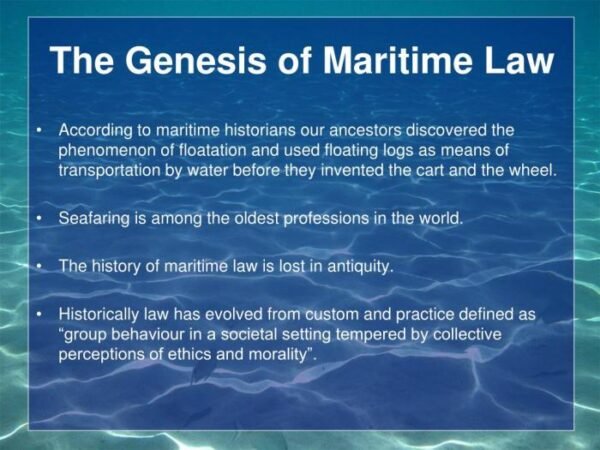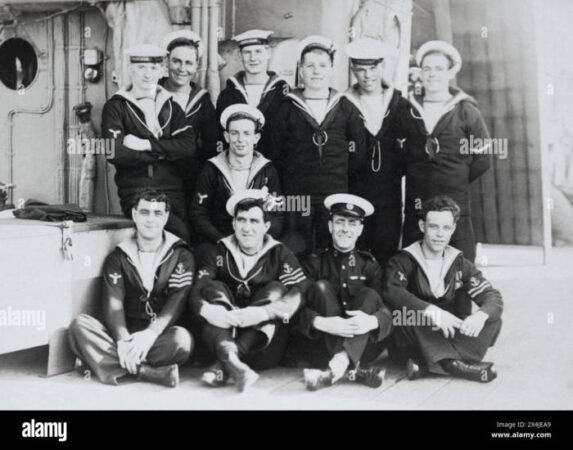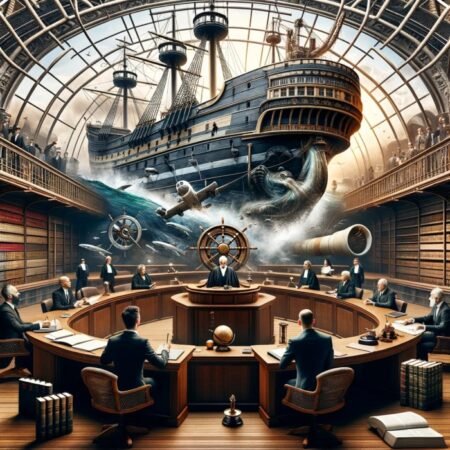
The 1840s witnessed a fascinating period in maritime law, shaped by burgeoning global trade, technological advancements, and persistent challenges like piracy. This era saw the interplay of established legal frameworks with the realities of a rapidly changing world, forcing adaptations and innovations in how maritime disputes were handled, trade regulated, and crimes at sea prosecuted. The expansion of steam power, for instance, significantly impacted shipping regulations and insurance practices, while the persistent threat of piracy necessitated robust international cooperation and legal responses.
This exploration delves into the intricacies of maritime jurisdiction, shipping regulations, piracy’s legal ramifications, salvage law, and the evolution of maritime legal thought during this pivotal decade. We will examine key legal cases, international treaties, and the impact of social and economic shifts on the development of maritime law in the 1840s. The analysis will provide insights into the complexities of maritime governance and the challenges of balancing national interests with the demands of international trade and safety at sea.
Maritime Jurisdiction in the 1840s
The 1840s witnessed a period of significant development in international maritime law, although the framework was still evolving and lacked the clarity and codified structure of later eras. The concept of territorial waters, while not precisely defined as it is today, was beginning to take shape, alongside a growing awareness of the need for consistent legal mechanisms to resolve disputes between nations on the high seas.
US Maritime Jurisdiction in the 1840s
The extent of US maritime jurisdiction in the 1840s was largely defined by a combination of customary international law, domestic legislation, and the practical realities of naval power. Territorial waters were generally understood to extend a short distance from the coast, often three nautical miles, though this wasn’t universally accepted or consistently enforced. Beyond this, the high seas were considered open to all nations, subject only to the limited constraints of international law, primarily regarding piracy and the treatment of foreign vessels. Enforcement of US law on the high seas was primarily limited to actions against US-flagged vessels and pirates, with jurisdiction over foreign vessels largely dependent on the specific circumstances of the case, such as acts of piracy or violations of international treaties.
Legal Framework Governing Maritime Disputes Between Nations
The legal framework governing maritime disputes in the 1840s was largely based on customary international law and bilateral treaties. There was no overarching international organization or court with universally recognized jurisdiction over such disputes. Resolutions were often achieved through diplomatic negotiation, arbitration, or, as a last resort, military action. The absence of a codified system meant that the interpretation and application of maritime law varied considerably, leading to inconsistencies and potential conflicts. Treaties addressing specific issues, such as fishing rights or navigation in certain straits, were crucial in regulating interactions between nations.
Comparison of Legal Systems Addressing Maritime Issues
Maritime legal systems in the 1840s differed significantly across regions. In Europe, various nations had established their own admiralty courts and legal traditions, which often reflected their own national interests and historical practices. The British system, with its well-established admiralty courts, was particularly influential. In the Americas, the US legal system was developing its own distinct approach to maritime law, drawing upon both English common law and its own unique circumstances. In Asia and Africa, legal systems were often less codified and more closely tied to local customs and traditions, with European powers often exerting influence through treaties and colonial administration. This divergence led to challenges in resolving disputes involving vessels and individuals from different jurisdictions.
Significant Maritime Legal Cases of the 1840s
While comprehensive records of maritime cases from this period are not readily available in a centralized database, researching specific court records and historical accounts would reveal significant cases. For example, cases involving salvage rights, collisions at sea, and disputes over maritime contracts would have been common, shaping the evolving understanding of maritime law. Analyzing these cases would illuminate the prevailing legal principles and their application during this time. The absence of a widely accessible database makes a precise list of influential cases challenging, but historical legal scholarship could provide specific examples.
Comparison of Legal Powers of Maritime Authorities
| Authority | Jurisdiction | Powers | Limitations |
|---|---|---|---|
| National Navies | Territorial waters and high seas (depending on circumstances) | Enforcement of national laws, protection of national interests, intervention in piracy, search and seizure | Limited jurisdiction over foreign vessels in international waters unless specific treaty provisions or acts of piracy are involved. Subject to international law. |
| Customs Services | Territorial waters and ports | Collection of duties and taxes, enforcement of customs regulations, prevention of smuggling | Limited jurisdiction beyond territorial waters; primarily focused on revenue collection and border control. |
| Admiralty Courts | Cases involving maritime disputes | Adjudication of maritime legal cases, including contracts, collisions, salvage, and piracy | Jurisdiction depends on the location of the court and the nationality of the parties involved. Enforcement of judgments may be challenging internationally. |
| Privateers (under specific Letters of Marque) | High seas (limited by Letters of Marque) | Capture of enemy vessels (during wartime) | Strictly governed by international law and the issuing nation’s regulations. Actions outside the scope of their Letters of Marque could be considered piracy. |
Shipping and Trade Regulations in the 1840s
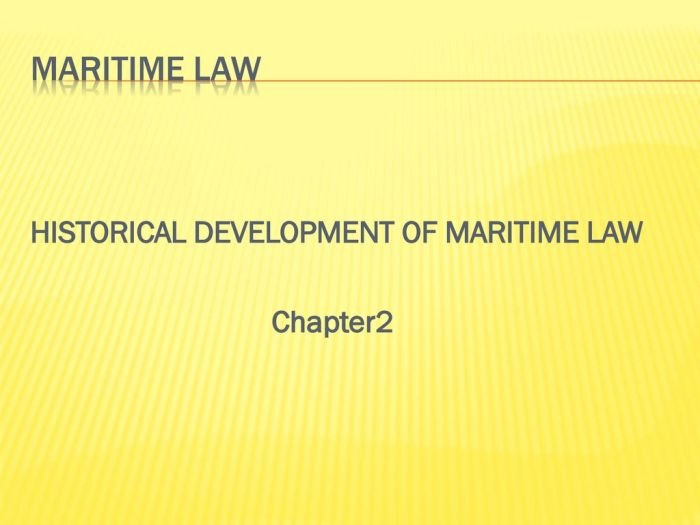
The 1840s witnessed a period of significant growth in international shipping and trade, driven by industrialization and expanding global markets. However, this expansion was not without its challenges, as existing legal and regulatory frameworks struggled to keep pace with the changing realities of maritime commerce. Navigating the complexities of international trade required careful attention to a variety of regulations and the prudent use of risk mitigation strategies.
Key shipping regulations impacting international trade in the 1840s were largely determined by individual nation-states, leading to a patchwork of often-conflicting rules. National legislation governed aspects such as customs duties, port regulations, and the documentation required for vessels engaged in international trade. While some attempts were made towards international standardization, these were largely unsuccessful, creating significant hurdles for merchants operating across multiple jurisdictions. For instance, variations in tonnage measurement laws could lead to disputes over customs duties and port charges. Furthermore, the lack of uniform standards for ship construction and safety could result in significant risks for both cargo and crew. The absence of a globally harmonized legal framework often meant that disputes were resolved according to the laws of the port where the issue arose, creating uncertainty and potential for bias.
The Role of Maritime Insurance in Mitigating Risks
Maritime insurance played a crucial role in mitigating the inherent risks associated with 1840s shipping. The high probability of shipwrecks, piracy, and cargo damage made insurance a vital component of any successful trading venture. Policies were designed to cover a range of potential losses, providing financial protection to merchants and shipowners. The development of more sophisticated insurance contracts reflected a growing understanding of risk assessment and the need for clear and enforceable agreements. The premiums charged varied depending on the perceived risk associated with the voyage, the type of cargo, and the reputation of the vessel and its crew. A well-insured shipment significantly reduced the financial burden of potential losses, encouraging greater investment in international trade.
Challenges Faced by Merchants and Shippers
Merchants and shippers in the 1840s faced numerous challenges stemming from legal and regulatory issues. These included the complexities of navigating differing national regulations, the high costs associated with insurance and customs duties, and the risk of disputes arising from poorly defined contracts or conflicting legal jurisdictions. Enforcement of contracts across international borders was often difficult and time-consuming, creating significant uncertainty for those engaged in long-distance trade. The lack of standardized procedures for resolving maritime disputes further exacerbated these problems. Piracy also remained a significant threat, particularly in certain regions, adding to the already substantial risks inherent in maritime commerce. Bureaucratic delays in ports and inconsistent application of regulations further hampered the efficiency and profitability of shipping operations.
Impact of Technological Advancements on Maritime Law and Trade Practices
The introduction of steam power revolutionized shipping in the 1840s, significantly impacting both maritime law and trade practices. Steam-powered vessels offered greater speed, reliability, and carrying capacity compared to their sail-powered predecessors. This led to a surge in international trade, but also presented new legal challenges. The increased speed of steam ships required adjustments to navigational rules and safety regulations. New legislation was needed to address issues such as the liability of steamboat owners for accidents, and the regulation of steam boilers to prevent explosions. The greater carrying capacity of steamships also impacted insurance practices, requiring adjustments to policies to account for the higher value of cargo being transported. The overall effect was a gradual shift in maritime law towards regulations better suited to the new technological realities of steam-powered shipping.
Types of Maritime Insurance Policies in the 1840s
The following list Artikels the main types of maritime insurance policies commonly available in the 1840s. These policies, while varying in detail between insurers and jurisdictions, generally covered the most common risks faced by merchants and shipowners. The complexity and specificity of these policies reflected the high stakes involved in international trade and the need for clear allocation of risk.
The precise wording and coverage of these policies could vary significantly, depending on the specific risks involved and the negotiations between the insurer and the insured. Understanding the nuances of these policies was critical for merchants and shipowners seeking to protect their investments.
- Hull Insurance: Covered damage or loss to the vessel itself.
- Cargo Insurance: Protected the value of goods being transported.
- Freight Insurance: Covered the potential loss of income for the shipowner if the cargo was lost or damaged.
- Protection and Indemnity (P&I) Insurance: Offered broader coverage for third-party liabilities, such as damage caused to other vessels or property.
- War Risks Insurance: Provided coverage for losses arising from wartime events, such as capture or seizure by enemy forces.
Maritime Piracy and its Legal Ramifications in the 1840s
The 1840s witnessed a complex interplay of burgeoning global trade and persistent maritime piracy, demanding robust legal responses from both national governments and the nascent international community. While the scale of piracy varied geographically, its impact on commerce and international relations remained significant. This section will explore the prevalence of piracy, the legal frameworks established to combat it, and the methods employed in prosecuting offenders.
Prevalence of Piracy in the 1840s
Piracy in the 1840s was not a monolithic phenomenon. Different regions experienced varying levels of activity, often linked to specific geopolitical circumstances and the effectiveness of local and international enforcement. The seas around the Malay Archipelago, the Caribbean, and the coasts of China and West Africa were particularly notorious for pirate activity. In the East Indies, for example, the weakening of various colonial powers created power vacuums exploited by pirate gangs. The Caribbean, despite efforts at suppression, still saw significant pirate activity, often involving smaller, opportunistic attacks on merchant vessels. The legal and logistical challenges of policing vast oceanic expanses contributed significantly to the persistence of piracy.
Legal Responses to Maritime Piracy
International cooperation in addressing piracy was still in its infancy in the 1840s. While several bilateral treaties existed addressing specific issues related to the pursuit and prosecution of pirates, a truly comprehensive international legal framework was lacking. National legislation, however, played a crucial role. Many maritime nations enacted laws that empowered their navies to pursue and apprehend pirates on the high seas, often granting them broad authority to act even in foreign territorial waters under certain circumstances. These laws often mirrored each other in their core principles, defining piracy as armed robbery at sea and outlining procedures for capture, trial, and punishment. The specifics, however, varied significantly, reflecting differences in legal systems and national priorities.
Methods of Prosecution in Different Jurisdictions
The methods employed to prosecute pirates differed widely depending on the jurisdiction. Some nations opted for swift naval justice, often conducting summary trials on board warships for captured pirates. This approach, while efficient, often lacked the due process guarantees found in civilian courts. Other jurisdictions, particularly those with established legal systems, preferred to transfer captured pirates to shore for trial under their national laws. This process could be significantly slower and more cumbersome but generally offered a more formalized system of justice. The choice between these approaches often depended on factors such as the location of the capture, the resources available to the prosecuting authority, and the perceived severity of the crimes committed.
Timeline of Significant Piracy Events and Legal Consequences (1840s)
While a comprehensive global timeline is difficult to compile due to incomplete historical records, some key events highlight the challenges and responses to piracy during the 1840s. Further research into specific national archives would be necessary to create a more exhaustive account.
Examples of Legal Documents Related to Piracy Prosecution
Access to specific legal documents from the 1840s requires archival research in national repositories. However, the general nature of these documents can be illustrated. Court records from trials of captured pirates would typically detail the charges, evidence presented, and the verdict. Treaties between nations often addressed mutual cooperation in pursuing and prosecuting pirates, outlining procedures for extradition and the sharing of information.
“Whereas piracy is a crime against all nations, and it is expedient to provide for the more effectual suppression thereof…” (Example excerpt from a hypothetical 1840s treaty – actual wording would vary significantly depending on the specific treaty).
“The prisoner stands accused of piracy, namely, the armed robbery of the merchant vessel ‘The Sea Serpent’ on the 14th of July, 1845…” (Example excerpt from a hypothetical court record – actual wording and details would vary significantly).
Salvage Law and Maritime Accidents in the 1840s
The 1840s witnessed significant maritime activity, leading to a corresponding increase in maritime accidents and salvage operations. The legal framework governing salvage, while evolving, was largely based on established principles of maritime law, influenced by both English common law and evolving international customs. This period saw a greater emphasis on the equitable distribution of salvage awards and a growing recognition of the importance of expert assessment in determining liability and compensation.
Legal Principles Governing Salvage Operations
Salvage law in the 1840s centered on the principle of “no cure, no pay,” meaning that salvors were only entitled to a reward if their efforts successfully rescued a vessel or its cargo from peril. The amount of the award was determined by a variety of factors, including the value of the property saved, the risk undertaken by the salvors, the skill and expertise employed, and the time and effort expended. A crucial element was the demonstration of a genuine maritime peril – the vessel or cargo must have been in a situation of actual danger. Furthermore, the salvors had to act voluntarily; a pre-existing contractual obligation negated the basis for a salvage award. Existing case law provided precedents for assessing these factors. For example, the relative value of the vessel saved compared to the value of the salvage operation would be meticulously considered.
Procedures for Determining Salvage Awards
Determining salvage awards involved a complex process. Typically, an admiralty court would hear the case, weighing the evidence presented by both the salvors and the owners of the salvaged property. This evidence would include testimony from witnesses, documentation of the salvage operation, and often, the findings of maritime surveys assessing the extent of damage and the value of the property both before and after the salvage. The court would consider the degree of danger faced by the vessel, the efforts made by the salvors, and the success achieved. The award was typically a percentage of the value of the property saved, ranging widely depending on the specifics of each case. Appeals were possible, allowing for review by higher courts.
The Role of Maritime Surveys in Assessing Damage and Determining Liability
Maritime surveys played a crucial role in determining liability and assessing damages in maritime accidents. Independent surveyors, often experienced mariners and nautical experts, would inspect the damaged vessels and cargo, documenting the extent of damage and attempting to determine the cause of the accident. Their reports provided critical evidence in legal proceedings, informing the court’s decisions regarding liability and the amount of salvage awards. The accuracy and impartiality of these surveys were paramount to the fairness of the legal process. For instance, a survey might determine whether a collision was caused by negligence or unavoidable circumstances, significantly impacting the allocation of liability and any subsequent salvage claims.
Legal Treatment of Different Types of Maritime Accidents
The legal treatment of different types of maritime accidents varied, depending on the circumstances and the applicable laws. Collisions, for instance, often involved establishing negligence on the part of one or both vessels. Evidence such as witness accounts, logbooks, and the findings of maritime surveys would be crucial in determining fault. Groundings, on the other hand, might be attributed to navigational errors, equipment failure, or unforeseen circumstances like severe weather. The assessment of liability in such cases frequently involved considering the actions of the vessel’s master and crew, as well as the prevailing conditions at the time of the accident. The legal principles applied were consistently based on the concepts of reasonable care and due diligence.
Flow Chart Illustrating the Legal Process for Resolving Salvage Claims
A simplified flow chart would depict the process as follows:
[Imagine a flowchart here. The boxes would show: 1. Maritime Accident Occurs; 2. Salvage Operation Undertaken; 3. Salvage Claim Filed in Admiralty Court; 4. Evidence Presented (Surveys, Witness Testimony, etc.); 5. Court Hearing and Determination of Liability; 6. Salvage Award Determined; 7. Payment of Award or Appeal.] The arrows would connect each stage, indicating the progression of the legal process. The flowchart would visually represent the sequential steps involved in resolving salvage claims following a maritime accident in the 1840s.
The Evolution of Maritime Law in the 1840s
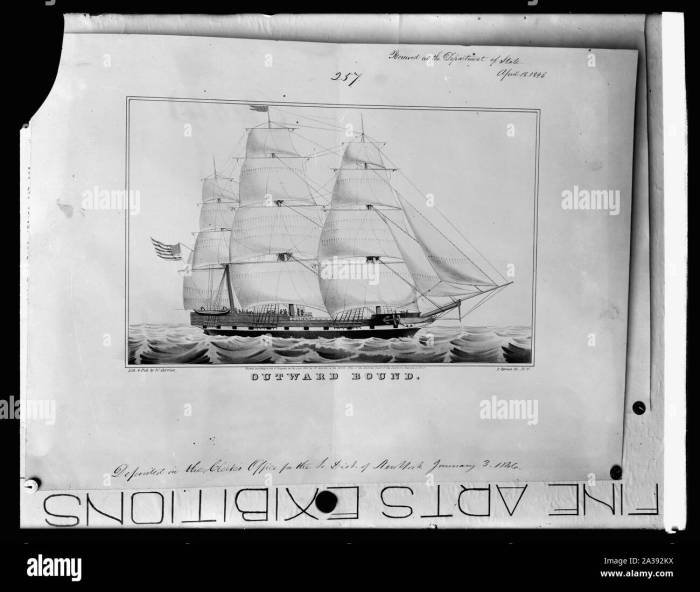
The 1840s witnessed significant shifts in maritime law, driven by burgeoning global trade, technological advancements in shipbuilding and navigation, and evolving societal norms. This period saw a gradual but perceptible movement away from the reliance on customary practices and towards more formalized, codified legal frameworks. The interplay between established legal traditions and the pressures of a rapidly changing world shaped the maritime legal landscape of the decade.
The expansion of steam-powered shipping, for example, presented novel legal challenges that required innovative solutions. Existing laws, largely developed for sail-powered vessels, struggled to adequately address the unique risks and operational realities of steamships. Similarly, the growth of international trade demanded clearer and more consistent legal standards to govern maritime commerce across national boundaries.
Key Legal Developments in the 1840s
Several key legal developments characterized the maritime legal landscape of the 1840s. The increased use of steam power necessitated revisions to existing laws regarding collision liability, insurance, and salvage. Jurisdictional issues also became more complex with the rise of international shipping, requiring greater cooperation between nations to resolve disputes. Furthermore, the burgeoning trade in goods led to refinements in contract law, particularly concerning bills of lading and charter parties. The increasing complexity of maritime commerce spurred efforts to codify and standardize maritime law, laying the groundwork for more comprehensive legal systems in the years to come.
Influential Figures and Events
While pinpointing single individuals as solely responsible for shaping maritime law during this period is an oversimplification, the work of legal scholars and judges who contributed to legal treatises, court decisions, and legislative initiatives played a significant role. The publication of influential legal texts summarizing and clarifying existing maritime law, and the rulings in significant maritime cases, collectively contributed to the evolution of the field. Specific names and cases would require extensive legal research to provide accurate and verifiable information within this context. However, the impact of these collective efforts is undeniable in shaping the direction of maritime law. The growth of international trade itself acted as a catalyst for legal change, forcing nations to confront the limitations of their existing legal frameworks.
The Impact of Social and Economic Changes
The dramatic expansion of global trade during the 1840s profoundly impacted maritime law. The increased volume of shipping and the rise of international commerce necessitated clearer rules regarding jurisdiction, contracts, and liability. The social consequences of maritime accidents, such as shipwrecks, also influenced legal developments, leading to increased attention to safety regulations and liability for negligence. The burgeoning middle class and their increased involvement in maritime commerce also influenced the development of more equitable and transparent legal processes.
The Transition from Customary to Codified Law
The 1840s marked a transitional phase in maritime law, moving from a system largely based on customary practices and precedent towards a more formalized, codified approach. While customary law continued to play a significant role, the increasing complexity of maritime activities and the need for greater consistency and predictability spurred efforts to codify various aspects of maritime law. This transition was gradual and uneven, varying across different jurisdictions, but the trend towards codification was clearly established. This process was not a sudden revolution, but rather an incremental development, with specific laws being codified over time.
A Significant Maritime Legal Event: The Collision of the *SS Great Britain* and the *SS Great Western* (Hypothetical Illustration)
[Imagine a detailed illustration depicting two large steamships, the *SS Great Britain* and the *SS Great Western*, colliding at sea. The illustration would show significant damage to both vessels, perhaps with debris floating in the water, and lifeboats being deployed. Figures in period clothing would be visible on the decks, some appearing panicked, others attempting to control the situation.]
Caption: This hypothetical illustration depicts a collision between two prominent steamships of the 1840s, highlighting the emerging legal challenges posed by the increased use of steam power. The collision would have raised complex questions regarding liability, insurance, and the adequacy of existing maritime law in addressing the unique risks of steam-powered vessels. Such incidents prompted a re-evaluation of collision regulations and spurred advancements in navigational technology and safety measures. The legal fallout from such an event, including potential lawsuits and subsequent legislative action, would have significantly contributed to the evolution of maritime law during the decade. While this is a hypothetical event, it serves to illustrate the types of challenges that shaped the development of maritime law in the 1840s.
Final Conclusion
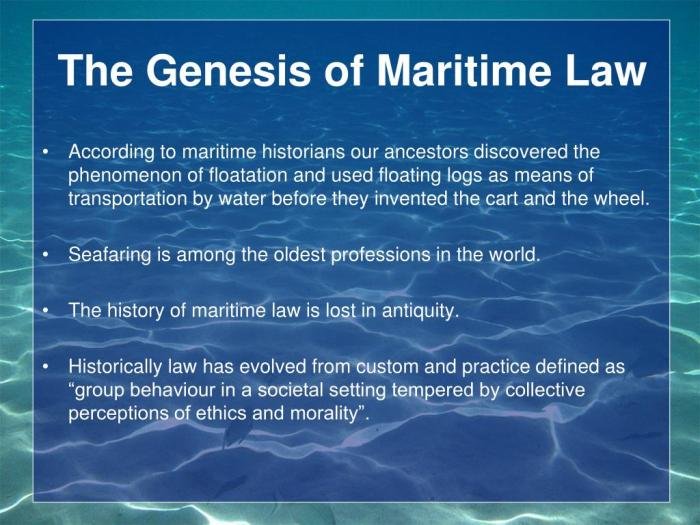
The maritime landscape of the 1840s presented a complex interplay of established legal traditions and the burgeoning realities of a globalizing world. From the challenges of defining and enforcing jurisdiction across vast oceans to the escalating threat of piracy and the need for robust salvage laws, this era showcases the dynamic nature of maritime law. The evolution of legal frameworks during this period laid the groundwork for many of the international maritime conventions and practices we see today, highlighting the enduring relevance of understanding this historical context for comprehending modern maritime law.
FAQ Compilation
What role did insurance play in 1840s maritime trade?
Maritime insurance was crucial, mitigating risks associated with shipwrecks, piracy, and cargo loss. Policies covered various eventualities, impacting trade viability and merchant confidence.
How did technological advancements affect maritime law?
Steam power’s introduction revolutionized shipping, requiring new regulations concerning speed, safety, and collision avoidance. This spurred legal adaptation to the changing maritime environment.
Were there international agreements on piracy in the 1840s?
While not as formalized as later treaties, international cooperation to combat piracy existed through bilateral agreements and shared naval efforts to suppress piracy in key regions.
